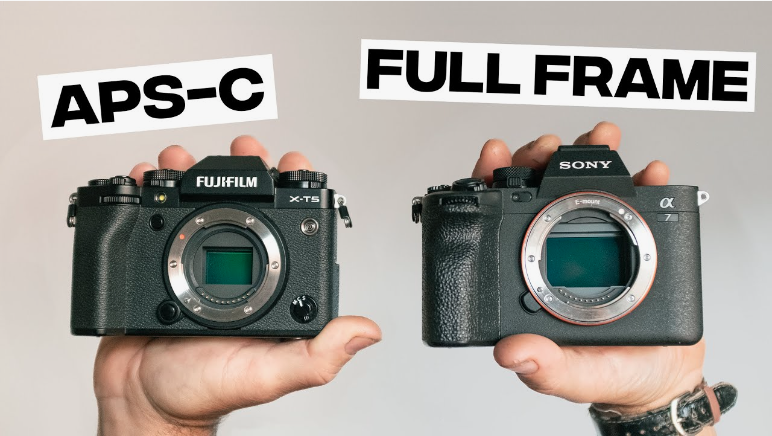Full Frame vs Cropped Sensor: Which Is Better for Portrait Photography?
If you’re a new photographer, terms like full frame and cropped sensor might sound confusing or irrelevant. But understanding these differences is crucial to improving image quality and choosing the right lens for your needs. Let’s dive into the details!
What Is a Full Frame Camera?
A full frame camera has a sensor equivalent in size to 35mm film, making it the largest sensor found in consumer cameras. These are often seen in professional or high-end cameras and are favored for their superior image quality.
Key features of full frame cameras:
- Larger sensors capture more light, resulting in better image quality.
- Typically more expensive, heavier, and bulkier (except for mirrorless models).
- Ideal for photographers seeking exceptional detail and dynamic range.
What Is a Cropped Sensor Camera?
A cropped sensor is a smaller sensor with a ‘crop factor’ that reduces the field of view compared to a full frame. This means your images will appear ‘zoomed in’ or cropped when using the same lens.
Cropped sensor cameras:
- More affordable and compact compared to full frame.
- Useful for niche photography, such as wildlife, where extra zoom is an advantage.
- Commonly found in entry-level or mid-range DSLRs and mirrorless cameras.
Why Are There Different Sensor Sizes?
The primary reason for sensor size variations is cost. Larger sensors are expensive to produce, so smaller ones make cameras more affordable for consumers. What Portrait Photographers Need to Know About the Exposure Triangle
In some cases, a cropped sensor can even be beneficial:
- For wildlife photographers, the crop factor provides extra reach, making it easier to capture distant subjects.
- However, for Portrait photography, a cropped sensor may limit your ability to capture wide, detailed scenes.
Full Frame vs Cropped Sensor: Which Is Better for Portrait Photography?
The choice between full frame and cropped sensor depends on your budget and needs.
Full Frame Advantages:
- Larger sensors capture more light and details, resulting in better image quality.
- Greater dynamic range and shallower depth of field, perfect for Portrait photography.
Cropped Sensor Advantages:
- Affordable and lightweight, making them accessible for beginners.
- Paired with the right lenses, they can still produce stunning Portrait photography.
How Sensors Impact Focal Length
The sensor type significantly affects how your lenses perform, especially their focal length.
The Crop Factor Explained:
A cropped sensor alters the effective focal length of a lens. For instance:
- A 50mm lens on a full frame provides a true 50mm field of view.
- On a cropped sensor with a crop factor of 1.5 (common for Nikon and Sony), that same lens behaves like a 75mm.
This means a cropped sensor captures a tighter frame, making it harder to fit everything into the shot at the same distance. Why Focal Length Matters in portrait Photography and How It Can Improve Your Shots
Choosing the Right Lens for Your Sensor
For Portrait photography, lens selection is key. Your sensor size will influence the focal length needed to achieve the desired look.
Here’s a quick guide:
- Flatlays and Overhead Shots
- Full Frame: Use a 50mm lens.
- Cropped Sensor: Use a 35mm lens (approx. 50mm equivalent).
- 45-Degree Angles with Background Blur
- Full Frame: Use a 100mm (or 105mm) macro lens.
- Cropped Sensor: Use a 60mm macro lens (approx. 90mm equivalent).
By adjusting your lens choice, you can achieve similar results regardless of your camera type.
How to Calculate Crop Factor
To find the equivalent focal length on a cropped sensor, use this formula:
Lens focal length × Crop factor = Effective focal length
For example:
- A 35mm lens on a cropped sensor (1.5x crop factor) behaves like a 52.5mm lens.
- A 100mm macro lens on a cropped sensor behaves like a 150mm lens, which might be too tight for Portrait photography.
Final Thoughts – Full Frame vs Cropped Sensor
While full frame cameras offer superior image quality, cropped sensors are more budget-friendly and accessible for beginners. The best choice depends on your budget and photography needs.
Key Takeaways:
- Full frame sensors provide the highest image quality but are pricier.
- Cropped sensors are cost-effective but require careful lens selection for specific photography styles.
- Understanding the crop factor ensures you choose lenses suited to your camera type.
No matter what sensor you have, the key is to practice and make the most of your gear. As you grow as a photographer, you’ll develop a deeper understanding of what works best for you.
Ready to find the best lenses for your camera? Start experimenting and watch your Portrait photography skills improve! All About Camera Modes for Beginner portrait Photographers
